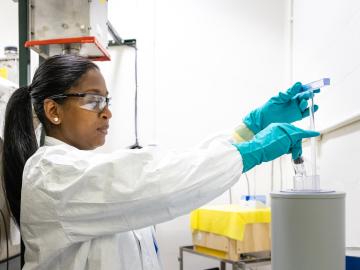
Filter News
Area of Research
- (-) Materials (18)
- (-) Supercomputing (63)
- Biology and Environment (28)
- Computational Biology (1)
- Computer Science (2)
- Energy Science (19)
- Fusion and Fission (3)
- Isotopes (17)
- Materials for Computing (4)
- National Security (21)
- Neutron Science (12)
- Nuclear Science and Technology (3)
- Quantum information Science (1)
News Type
News Topics
- (-) Clean Water (2)
- (-) Composites (2)
- (-) Computer Science (49)
- (-) Cybersecurity (2)
- (-) Isotopes (7)
- (-) Machine Learning (8)
- (-) Space Exploration (2)
- (-) Summit (22)
- 3-D Printing/Advanced Manufacturing (5)
- Advanced Reactors (1)
- Artificial Intelligence (22)
- Big Data (16)
- Bioenergy (5)
- Biology (6)
- Biomedical (8)
- Biotechnology (1)
- Buildings (3)
- Chemical Sciences (8)
- Coronavirus (7)
- Energy Storage (8)
- Environment (19)
- Exascale Computing (16)
- Frontier (17)
- Fusion (3)
- Grid (3)
- High-Performance Computing (25)
- Materials (22)
- Materials Science (25)
- Mathematics (2)
- Microscopy (9)
- Nanotechnology (11)
- National Security (3)
- Neutron Science (15)
- Nuclear Energy (12)
- Partnerships (3)
- Physics (15)
- Polymers (5)
- Quantum Computing (12)
- Quantum Science (11)
- Security (3)
- Simulation (12)
- Software (1)
- Transportation (7)
Media Contacts

The Oak Ridge Leadership Computing Facility, a Department of Energy Office of Science user facility at ORNL, is pleased to announce a new allocation program for computing time on the IBM AC922 Summit supercomputer.

The Department of Energy’s Oak Ridge National Laboratory hosted its Smoky Mountains Computational Science and Engineering Conference for the first time in person since the COVID pandemic broke in 2020. The conference, which celebrated its 20th consecutive year, took place at the Crowne Plaza Hotel in downtown Knoxville, Tenn., in late August.

Wildfires have shaped the environment for millennia, but they are increasing in frequency, range and intensity in response to a hotter climate. The phenomenon is being incorporated into high-resolution simulations of the Earth’s climate by scientists at the Department of Energy’s Oak Ridge National Laboratory, with a mission to better understand and predict environmental change.

Over the past decade, teams of engineers, chemists and biologists have analyzed the physical and chemical properties of cicada wings, hoping to unlock the secret of their ability to kill microbes on contact. If this function of nature can be replicated by science, it may lead to products with inherently antibacterial surfaces that are more effective than current chemical treatments.

As a result of largescale 3D supernova simulations conducted on the Oak Ridge Leadership Computing Facility’s Summit supercomputer by researchers from the University of Tennessee and Oak Ridge National Laboratory, astrophysicists now have the most complete picture yet of what gravitational waves from exploding stars look like.

Simulations performed on the Summit supercomputer at ORNL revealed new insights into the role of turbulence in mixing fluids and could open new possibilities for projecting climate change and studying fluid dynamics.

A study led by researchers at ORNL could uncover new ways to produce more powerful, longer-lasting batteries and memory devices.

A team of researchers from ORNL was recognized by the National Cancer Institute in March for their unique contributions in the fight against cancer.

A series of new classes at Pellissippi State Community College will offer students a new career path — and a national laboratory a pipeline of workers who have the skills needed for its own rapidly growing programs.

Environmental scientists at ORNL have recently expanded collaborations with minority-serving institutions and historically Black colleges and universities across the nation to broaden the experiences and skills of student scientists while bringing fresh insights to the national lab’s missions.


